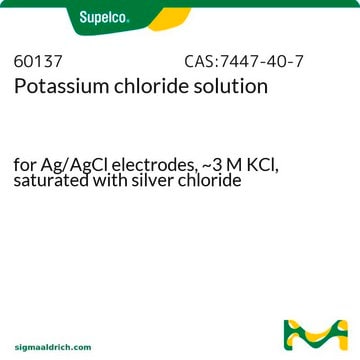449571
Silver chloride
AnhydroBeads™, −10 mesh, 99.998% trace metals basis
Synonyme(s) :
AgCl (Silver monochloride), Silver(I) chloride
About This Item
Produits recommandés
Pression de vapeur
1 mmHg ( 912 °C)
Gamme de produits
AnhydroBeads™
Pureté
99.998% trace metals basis
Impuretés
≤25.0 ppm Trace Metal Analysis
Taille des particules
−10 mesh
Pf
455 °C (lit.)
Chaîne SMILES
Cl[Ag]
InChI
1S/Ag.ClH/h;1H/q+1;/p-1
Clé InChI
HKZLPVFGJNLROG-UHFFFAOYSA-M
Vous recherchez des produits similaires ? Visite Guide de comparaison des produits
Catégories apparentées
Application
Informations légales
Mention d'avertissement
Warning
Mentions de danger
Conseils de prudence
Classification des risques
Aquatic Acute 1 - Aquatic Chronic 1 - Met. Corr. 1
Code de la classe de stockage
8B - Non-combustible corrosive hazardous materials
Classe de danger pour l'eau (WGK)
WGK 3
Point d'éclair (°F)
Not applicable
Point d'éclair (°C)
Not applicable
Équipement de protection individuelle
Eyeshields, Gloves, type N95 (US)
Certificats d'analyse (COA)
Recherchez un Certificats d'analyse (COA) en saisissant le numéro de lot du produit. Les numéros de lot figurent sur l'étiquette du produit après les mots "Lot" ou "Batch".
Déjà en possession de ce produit ?
Retrouvez la documentation relative aux produits que vous avez récemment achetés dans la Bibliothèque de documents.
Les clients ont également consulté
Articles
Plasmonic nanoparticles have unique optical properties that can be tailored to suit a variety of applications in the biotechnology1–8 and electronics9–16 industries.
Notre équipe de scientifiques dispose d'une expérience dans tous les secteurs de la recherche, notamment en sciences de la vie, science des matériaux, synthèse chimique, chromatographie, analyse et dans de nombreux autres domaines..
Contacter notre Service technique












